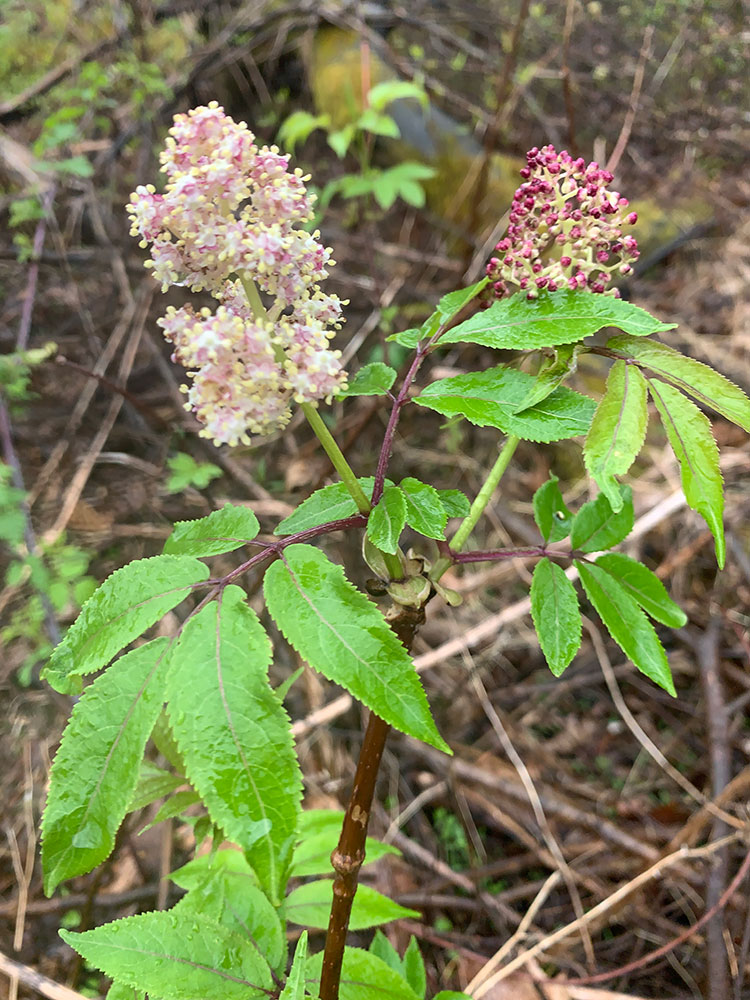
The property was almost perfect: in the right location, a natural spring as a water source, a small and nice house with a huge hearth, areas for chickens and gardens, a small pond, and a stream bordering the edge of the property….pretty much everything was exactly what we hoped. Except for one thing: right before selling the property, the previous owners did some logging for profit, taking out most of the mature overstory of trees on 3 of the 5 acres. This left the forest in a very damaged place: cut down trees, lots of smaller limbs and brush, often piled up more than 5-8 feet high in places. I remember when I went to look at the property and started walking the land and just saying, “Why would they do this?” It hurt my heart. Could I live here, seeing what had so recently been done? But I’ve always been led to such places as part of my spiritual path, particularly places that have been logged.
A continual theme of this blog is land healing. In some recent posts, I have been sharing some details about physical land healing: what to do, how to do it, what ecological succession is and how that matters, and also why you might take up the path of the land healer as a spiritual practice. In today’s post, I’m going to put these pieces together and share a specific example from the forest regeneration work we are doing at the Druid’s Garden Homestead. In the last two years, we have been developing methods to help support the ecosystem and foster ecological succession. With careful choices, ecological succession can be done faster and more effectively, helping shift our land to a mature ecological sanctuary for life. This is by no means a complete project but does offer a glimpse into what we are doing, some of the choices we made, and hopefully, after some time passes, I can offer some updates! The goal then is to offer you a model and ideas for work that you can do to heal in your own ecosystem from a physical land healing standpoint.
One of the questions that sometimes come up for people interested in land regeneration is this-if nature already knows how to heal herself, why would any person want to intervene? Why do the work of healing an ecosystem if nature can just do it herself on a slower scale? Most of the answers to these questions I shared in my earlier post on land healing as a spiritual practice. But I will share my reasoning for this specific piece of land: I feel the need to use things like permauclture to help the land regenerate because of the broader challenges we are facing environmentally and the importance of peacemaking with the spirits of the land. Given our situation here, it would take anywhere from approximately 50-100 years for this land to fully heal. But there is a question if it could ever fully heal due to the loss of certain woodland species from our immediate ecosystem–species that belong here like ramps, trillium, American ginseng, and more are not easily spread and may take hundreds of years to return, if at all. Further, our intervention could provide faster healing of this land and could build critical ecosystems and create a sanctuary for life in a time when it’s definitely needed. Our land here is a small patch of woods surrounded by many farmlands growing corn, soy, and cabbage. We are our own refugia here, and so, bringing this land back into a healthy place ecologically means that this can be a better refuge for life and support more animal, insect, bird, amphibian, reptile and plant lives. Also, by using the grove of renewal strategy (which I developed as part of this work), we can radiate this healing energy out to the broader landscape–where it is sorely needed.
Observing, Interacting, and Deep Listening
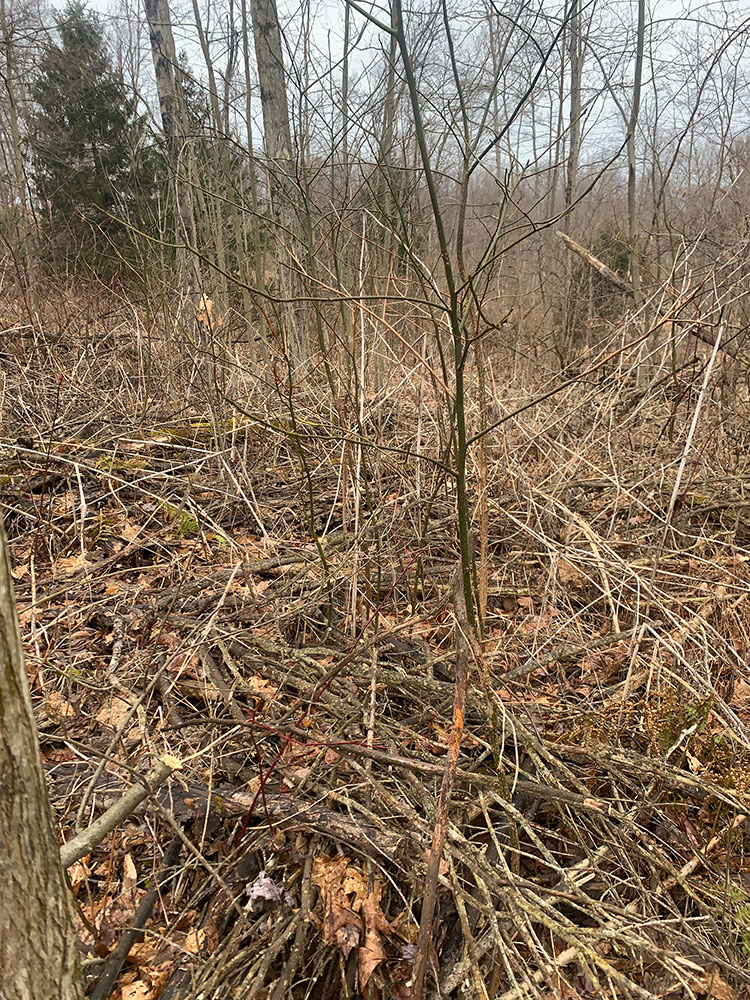
Each landscape is unique. If you are coming into a new land or working with land you’ve known for years, the first step is to observe, interact, and practice some deep listening. Observation and interaction are just as they sound–this is a principle from permauclture that says in order to work to regenerate land, you have to come at that work from a place of knowledge and wisdom. In order to know that land, you need to study that land–observe the land in different seasons and at different times of day, interact with the land, be present there always, seeing what there is to see, and come to know it deeply. Understand what is already growing there, if it’s native or opportunistic (I don’t like the word “invasive), who lives there, what the ecosystems surrounding your land look like, what pollution and other pressures there might be, and more.
With so much of our land subject to logging, we spent some time observing, interacting, and in connection with the spirits. What did the land spirits want us to do? What could we do that would be respectful to the land, that would help and not hurt further? The general sense we had was that to respond to this situation, we knew that there were places we were going to let nature heal in her own way, but there were also plenty of places that we could help heal faster by applying permaculture techniques. Observation and interaction is the physical component of this and deep listening is the spiritual component of this practice. But I also want to share here that observation, interaction, and deep listening is a continual process. As you work on a piece of land, you will keep working with it. What the land may ask you to do changes as you complete earlier work. So keep on listening, every chance you get. I’ll now consider each in turn.
Observation and Interaction: The Lay of the Land
Being on the land after moving in was honestly overwhelming. Much of the land was impassible due to the huge amounts of leftover treetops, branches, and brush. The loggers had just bulldozed brush into large piles, taking much of the forest floor with it. The first thing we did, even to begin to observe and interact, was to re-establish paths by moving brush so we could walk and be present on the land. Since this was so-called “sustainable logging” what we ended up with was most of the largest trees being taken and a smattering of mature trees left–some oaks, hickories, maples and black cherries. Thus, we have some mature trees. But many of the mature trees that find themselves exposed to wind are experiencing secondary loss, where they lose their crowns. These trees grew up in a mature forest with close crowns, without the protection of other trees, they are very susceptible to wind damage. This is one of the things we are observing now–losing a lot of the remaining crowns of the largest trees, which is very sad. We also have a good understory of hickory, oak, sugar maple, cherry, and a bit of sassafras–these trees will eventually be our new overstory, I think, once the secondary loss of the larger trees concludes.
The amount of brush also made it harder for smaller trees to grow and come up in a healthy way, and the brush is covering the trunks of many of the existing trees that were not logged, creating wet spots that can cause the trees’ bark to rot. The forest floor wasn’t very abundant–we weren’t seeing a lot of the plants that should be growing here, particularly woodland medicinal species.
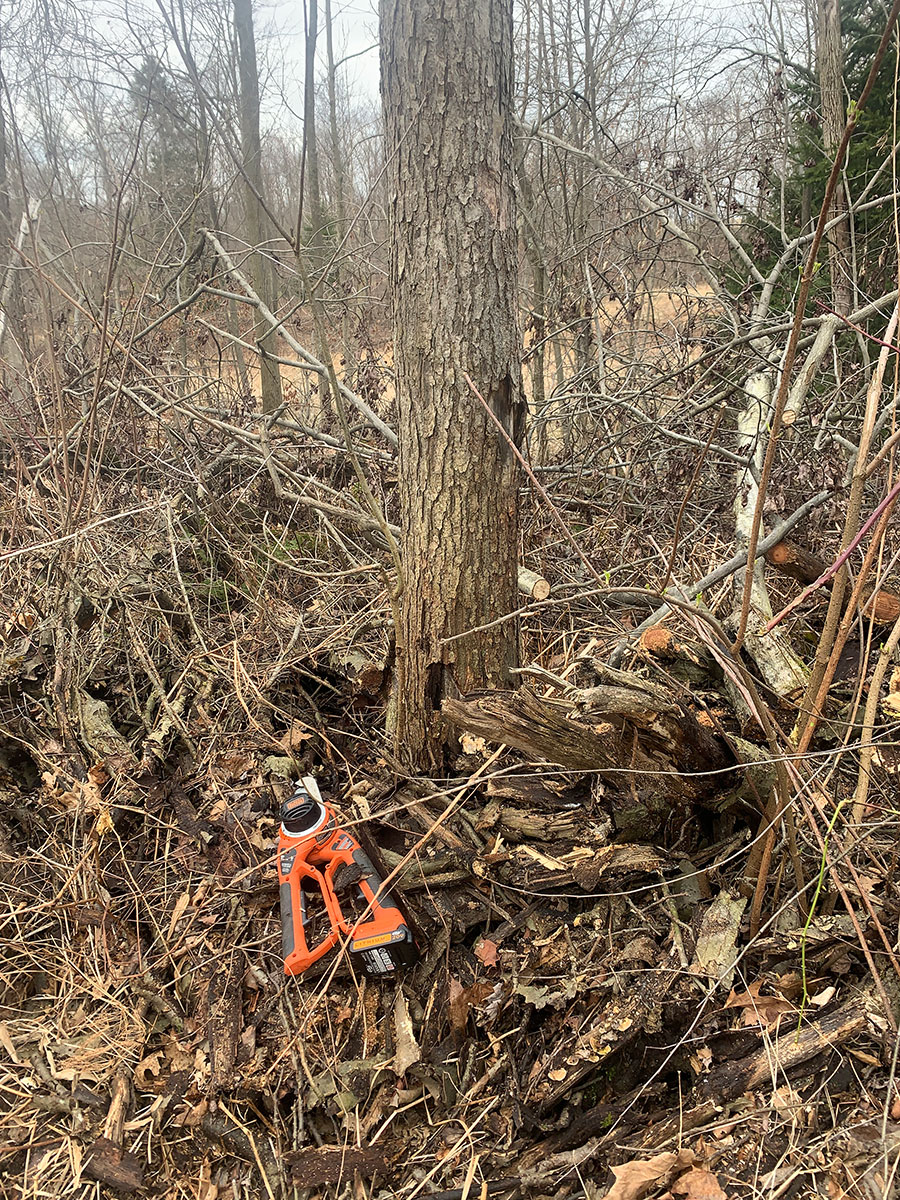
At present, after logging, the dominant plant that has grown up on our landscape is the Rubus allegheniensis, the common blackberry, native to this area of our land. We now have large thickets of blackberry. We also have Devil’s walking stick, wild cherry, elderberry, spicebush, and beaked hazels growing up in very dense thickets. We also have a lot of poison ivy, as it thrives on disturbance. These plants have quickly come into the spaces left by large trees to fill the void. But if we want to support ecological succession, we’d work to plant and foster the hardwood trees as much as possible and help cultivate them towards adulthood along with supporting a rich understory of shrubs and woodland plants of more diversity than the opportunistic species that are present.
Our land is on the eastern side of a small mountain, so we get good morning/early afternoon light and get more shade in the evenings. The soil is wet and fertile. The bottom of our property borders Penn Run, a stream that is clean and flowing where we live, but most, unfortunately, less than 1/4 mile from where we live downstream, we have acid mine drainage causing serious pollution. Thus, cultivating the health of our stream is of utmost concern as it fosters habitat that is degraded further down.
Deep Listening: The Will of the Spirits of the Land
The second part of this equation is deep listening. For generations, this land been the object of someone else’s desire–in the sense that whatever humans wanted to do to the land, they simply did, with no consideration of the will of the spirits of the land. As druids, we recognize that the land has agency–it has a voice, and we listen. Thus, part two of the observation and interaction is simply finding out what the spirits of the land want and desire–and following that will. I really believe this is one of the most critical parts of land healing and any other spiritual work we do–and failing to do this part means we are no different than others who have come and did whatever they wanted. For the last two years, we haven’t done much beyond our gardens, chicken coops, and infrastructure (fencing for garden, etc). We wanted to listen to what the spirits of the land wanted for the healing of the rest of the property, especially the forested sections. Over time, a clear message emerged–certain areas to let “rewild” without any intervention and without any human interaction, while other places on the property places for spiritual activity, replanting, and active regeneration. The spirits gave us a map of the land and how they wanted us to proceed–and we listen.
Goals and Interventions
Most people who are working on conservation, permaculture design, forestry, and so on recommend developing clear goals that help you decide how to create a plan moving forward and make sure your actions align with that plan. I also think this is a really good idea. To replant our land and heal the forest, we started by identifying clear goals for our forested areas and for ourselves. These goals include:
- Honor nature in our actions and in our intentions and work with nature as a partner in the regeneration process.
- Support ecological succession to help re-establish an overstory of hardwood nut trees and sugar maples in 3 acres of forest. This will include supporting a diverse ecosystem, modeled after old-growth ecosystems of the “Northern Hardwood Forest” type.
- Maximize habitat and food sources for wildlife and humans (including amble supplies of wild berries and nuts) focusing on perennial agriculture
- Establish a sanctuary for endangered woodland medicinal species in our 3 acres of forests in the understory (American ginseng, black cohosh, blue cohosh, trillium, bloodroot, ramps, etc, as established by the United Plant Savers)
- Designate “wild areas” (zone 5 areas, to use the term from permaculture design) that are untouched can regenerate in whatever direction spirits will.
- All human-focused and agriculturally-focused areas will be designed and enacted based on working with nature using permaculture design. Human focused areas have the emphasis of people care, earth care, and fair share. Spiritual areas are designated for our grove and spiritual community.
- Learn how to support riparian and wetland ecosystems. We have a special emphasis on wetland areas and riparian zones, since our land contains both a small spring-fed pond and a clean stream.
- Learn how to use all of the materials on our land so that nothing is wasted. We have a lot of secondary tree loss right now, and we don’t want to add to the brush on the ground. Thus, when a tree drops, we are doing our best to use it in some way, either for woodworking/arts/crafts, for natural building projects, or for firewood or hugels (see below).
- Build resiliency for ourselves, our domestic animals, and all life on our property.
These goals are evolving as time passes, but they represent our general desire to be good stewards of this land, allow for us to live here in harmony with life, and support more diversity of plant, bird, animal, and insect life.
Ecological Succession Support and Forest Restoration
The following are some of the main strategies we are using at present for regeneration. We are still very much in the early stages here of this regeneration project, but we’ve got good momentum and are making progress!
Tree Replanting and Cultivation. We’ve been working to replant as much of the understory as possible so that we can establish, in time, a healthy and diverse overstory. This included planting 25 American hybrid chestnut trees (blight resistant, 95% American chestnut genetics), planting oaks and hickory nuts throughout the areas we could access, as well as establishing a paw-paw understory. There were very specific reasons for these choices: according to my own historical research, chestnut used to comprise about 30% of our forests here in PA and PawPaw was quite common. The logging gave me a chance to try to establish a mature chestnut overstory in the long run. These trees are still small, but we are keeping them clear of brush and debris and doing our best to make sure they are established.
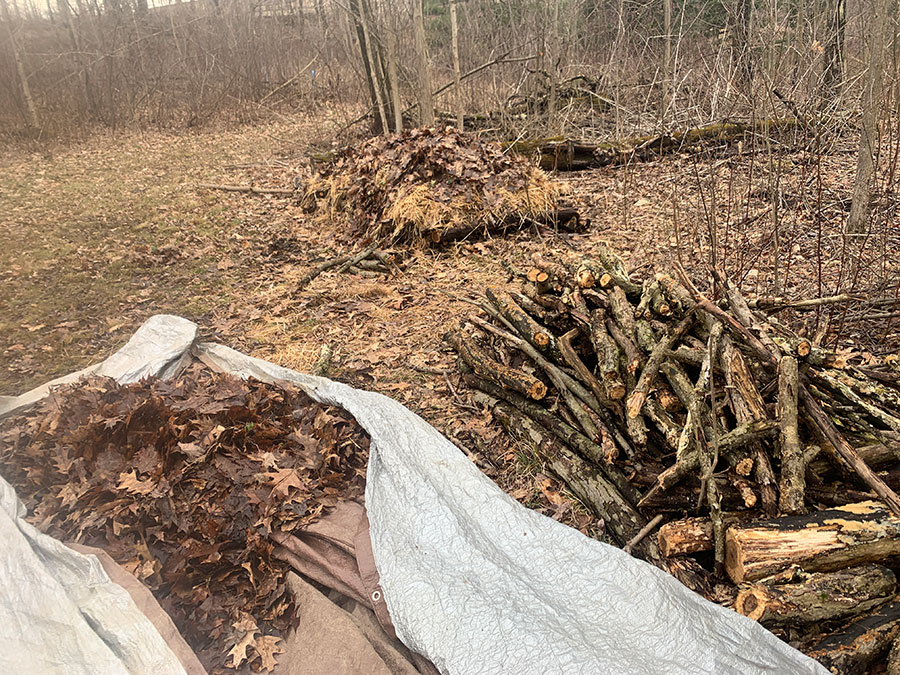
Tree tending and thinning. When there are dense thickets of small trees regrowing, only the strongest or fastest-growing will survive. We have identified different patches of regrowing trees and are trying to cultivate those which will contribute most to a mature oak-hickory overstory and a wide diversity of trees. One of the most recent projects was clearing the brush (through hugelkultur techniques, see below). We cleared brush from a large patch of sassafras trees (the only on the property) and making sure they had room to grow. We have been thinning the dense thickets of the weakest trees to ensure more rapid growth, especially of the beaked hazels, which grow very, very quickly and can overpower our slower-growing hickories, oaks, and chestnuts. This process of tending and thinning has created a lot of branch and pole material we can use for garden stakes and other spiritual building and crafting projects. And doing some thinning like this helps tend the ecosystem. We never cut anything back without permission–and listen carefully to what the spirits of the land and forest ask.
Clearing brush and turning “waste” into a resource. Perhaps the most intensive of the work we are doing right now is clearing areas of the downed trees and brush. As long as we have piles of 8′ brush, it makes it very hard to plant young trees, allow the small seedlings to grow, or replant the forest floor with woodland medicinals. The brush has also been piled near living larger trees, which can create rot at the roots and cause more secondary tree loss. We have selected several areas to target, being led by the spirits of the land, and have intentionally done minimal work in others, only enough to ensure that small seedlings aren’t trapped and that roots and trunks aren’t covered in downed wood debris. This involves primarily a lot of chainsaw work. We are using primarily battery-powered power tools and some hand tools; the battery-powered tools are charged by our solar panels, reducing our fossil fuel consumption.
We go into a brushy area where the brush is, and start clearing. What we can take as firewood we will take as firewood. Its been two years since the logging, but because a lot of the wood is off the ground, we have a surprising amount of wood still to harvest for firewood. For wood that is past firewood stage, we have been building forest hugelkultur beds (see next entry). Once the forest floor has the brush mostly clear, we can then plant other kinds of forest medicinals and plants.
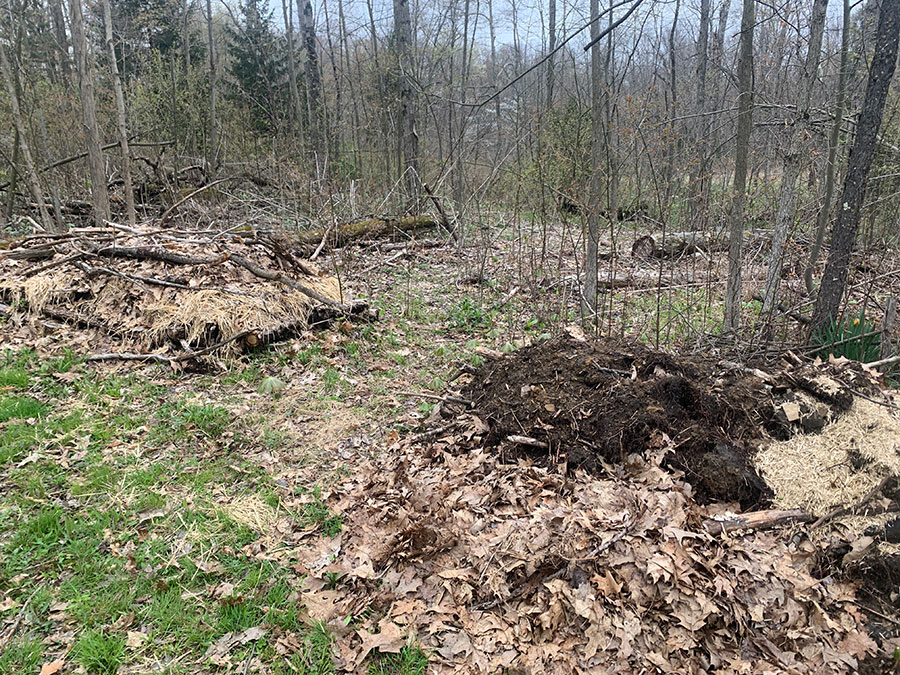
Forest Hugelkultur Beds. Hugelkultur, which basically means “mound culture” is an old-world technique popular in Germany that adds woody matter to create raised “mounds” that can be grown in. This is a fantastic technique for us to employ here because we have an over-abundance of partially rotting wood and brush that we want to find a productive use for. By making the hugelkultur beds, we take areas that are currently prevented from effectively regrowing due to the nature of the bush, clear the brush, and end up with a valuable resource–a new bed that we can plant. Most of ours hugels are in part-shade forest edges where we will plant shrubs and other shade-loving perennials to increase our capacity for food production for ourselves and wildlife: gooseberry, fiddlehead ferns, alpine strawberry, black and red currants, etc.
To build a hugel, you decide your location. You can also decide at this point if you want to sink it into the ground (like a traditional garden bed where you’d dig down) or put it on top of the ground. We are doing above ground hugels primarily because our ground is so rocky and digging it out is almost impossible. Once you have your location, you start with the largest pieces of wood and begin making a very dense pile of wood the size you want your bed to be (at least a few feet long and a few feet wide, realistically). As you pile them up, usually to 3-4′ tall, you vary the thickness of the wood, such that the thickest wood should be on the bottom and inside the middle, and thinner sticks, etc, should be on the outside. After you have your pile, you can add whatever other organic matter you have around–we clean out our chicken/guinea, duck, and goose coops regularly and are using all the straw bedding as another layer. Stuff that material into any of the holes between the logs. Finally, we top it with more layers of organic matter (leaves, compost, etc) and top it off with at least 4″ of finished compost. The final layer is a layer of straw. These layers, we allow to “season” for at least six months to a year. By the second year, the hugels have settled enough that you can patch any holes with additional compost and then plant right in them. Each year, as they season more and more, they grow more abundant. We have some hugels we did dig down and create as part of our medicinal herb garden and they are incredibly productive and resilient after only two years! The goal here is that the hugels will edge our deeper parts of our forest and provide abundant food and forage for wildlife and humans.
I will also say that this kind of hugel building work in the way we are doing it is dark half of the year work. If you clear in the winter, you don’t disrupt the soil or perennials that are going to come up in the summer months. For us here, we can do this work from Samhain to somewhere close to Beltane–then we shift our emphasis on other things for the summer months and come back to clearing and hugelkultur work in the winter months.
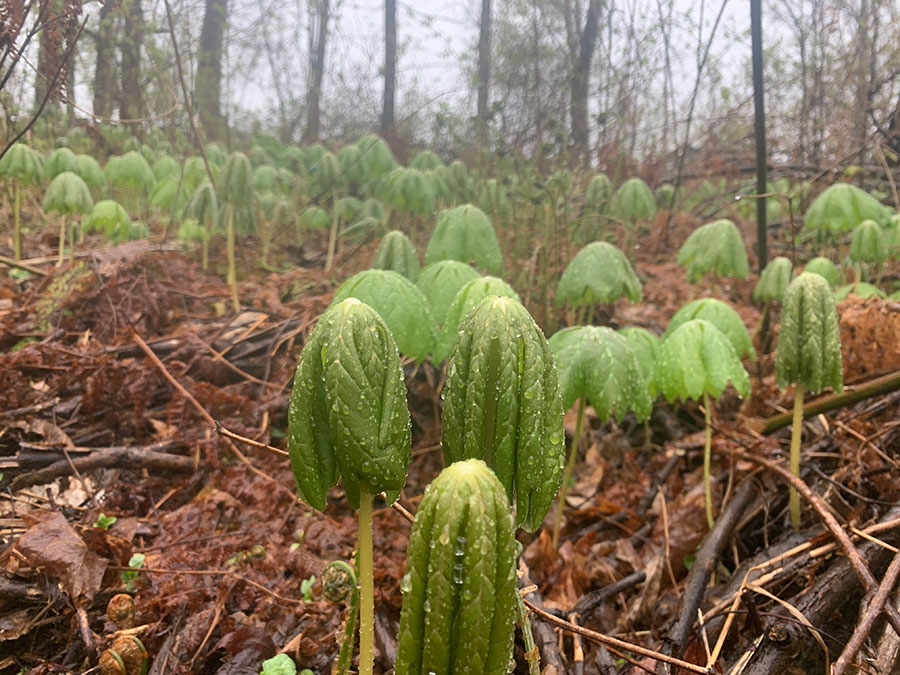
Seed scattering and re-establishing forest medicinal species. We are working to model our regenerated forest after what an old-growth forest would have looked like, as our goals above suggest. Thus, we have been replanting many lost forest medicinal and keystone woodland species that are native to our area. This includes scattering about 1000 ramp seeds, planting over 50 American ginseng roots and planting more wild ginseng seeds, bringing in bloodroot, black cohosh, trout lily and other plants that are adapted particularly for our damp hillside. We are still pretty early in this process (we have to get the downed wood brush cleared first) but are making good progress and have already scattered and planting the ginseng and ramps.
Overstory management. As I mentioned above, one of the saddest things happening now deal with the loss of the remaining trees still standing in the forest–we are observing these trees and seeing how many of them can make it. But we also recognize the value of standing dead timber, and since we have a nice woodpecker community (at least four different species, including the rarer Pileated Woodpecker), we are leaving all of the standing dead timber that is safe to leave–which thankfully, is nearly all of it. For some trees, however, particularly those that may be in a place that if they dropped would cause damage to other trees or the house/structures, we are dropping them and using them for natural building, firewood, and other projects.
What about the inner/energetic work?
Reading all of this, you might notice that I’ve primarily talked about physical regeneration in today’s post. Yes, I have. As you might recall from my earlier work, I really see land healing as both inner and outer work. Because I have the power to do something physical, I think its really important that those things are done. On the spiritual side, I’m working on the grove of renewal here on the land as well as ongoing land blessing and land healing work. While we do the physical work, the energetic work is always present. The two work together, and each strengthens the other.
Conclusion
Whew! That’s a lot going on at the Druid’s Garden homestead. Its good work to do, especially now with the pandemic. We don’t want to leave the land much, so we are turning in earnest to our projects here that will help regenerate and heal this beautiful landscape. I’ll work to provide periodic updates on these projects and how they are going. In the meantime, I hope everyone is having a nice spring and thinking about their own healing projects. I would love to hear what things you are working on or the plans you have!


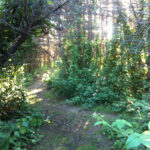

Reblogged this on Blue Dragon Journal.
Thanks for the reblog! 🙂
Thank you for this wonderful analysis of regenerative land practice, especially the need for listening and studying the ways of the land itself. I am working on a Re-Imagine Appalachia that includes regenerative agriculture as a major component. I intend to include reforestation with permaculture as a land healing component. I would love to talk with you, if you could spare me an hour? I am demarcop6@gmail.com You can see some of my work at patriciademarco.com
Blessed Be
Hi Patricia, sure, I’m happy to reach out. I hadn’t heard of Re-Imagine Appalachia, but I’m in Appalacia too! Thanks for the info!
Reblogged this on Paths I Walk.
Thanks for the reblog! 🙂
Inspiring! I’ve began to really learn about permaculture and incorporate it into my gardens and approach to fostering diverse, mutually supportive, and beautiful systems. It’s endlessly engaging and creative! And I try to counteract my direct neighbors who spray the crap out of their yards 🙁
That’s all we can do, right? Do good in the world, try to set a good example, and honor the land we have to work with. I look forward to hearing more about the projects you are working on, if you are willing to share! 🙂
I’ve planted for pollinators for a long time, but I’ve been slowly reading Gaia’s Garden and started looking towards pollinator plants with multiple useful purposes, like Comfrey, so it can help improve the clay soil of that garden bed. I’ve also started to mix perennials and vegetables together, now that I’m trying to grow veggies really for the first time. I’m also guerilla replanting Dwarf Joe Pye Weed along the forest edge as it overgrows my front yard bed.
Thank you for writing about it and more importantly thank you for doing it. I wish I was able to find a group similar to the one you describe. I live in the middle of a city and have worked for 20 odd years on amending soil here and planting flowers and ferns native to this region (Minnesota), for pollinators and birds and so forth. I started out not really knowing what I was doing and have made mistakes that I’ve since tried to rectify, hopefully not creating a bigger mess in the process. I’m not even sure, sometimes, why I am doing this, since at any time I could sell and go somewhere else with less work. And there’s no one for it to pass to when I die. But somehow I remain here, like a caretaker or something. It reminds me sometimes of characters in faerie tales who is charged to remain in place. Maybe I’m holding place for the next ones… I don’t know, I struggle with doubt all the time. And it’s a ridiculous amount of space for one person, as well, although I have had a friend staying with me until this summer. I have put out some feelers hoping to draw a likeminded person or two, because eventually it will become more than I can handle. But so far the clues and directives for what to do next are slow in coming.
Hi Kieron, I think we’re all temporary caretakers of land. For whatever reason, you are there, right now in this time. And so, as the saying goes, grow where you are planted. And make change when change is due! :). Blessings to you and thank you for reading!
I do not know you, and sadly will probably never meet you, but thank you. Thank you so much for all your doing. For protecting that patch of Earth.
Aww, thank you, Mark! And thank you for reading :).
Reblogged this on Patricia DeMarco Ph.D. and commented:
Insightful, practical and inspiring piece on forest regeneration. With all the environmental damage inflicted on our forests for human extractive industrial uses, this is an important perspective. I would advocate for policies that REQUIRE a re-forestation plan as a condition for any commercial use of forest land. With Admonitions to consider sustainable uses as a priority, as are suggested in this article showing ways to recover poorly planned logging.
Thank you for reblogging, Patricia! There is much left to do!